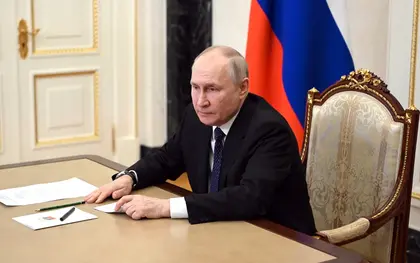Monday’s attack on the Kerch Bridge in Russian-occupied Crimea has prompted a flurry of activity in the Kremlin and some extraordinary travel advice for tourists fearful of staying put.
President Putin on Monday vowed to retaliate adding that he was “waiting for specific proposals” to improve the security of the bridge, which Sergey Aksyonov, the Russian-appointed “head of Crimea” had claimed had been put in place after it was first attacked in October of last year.
JOIN US ON TELEGRAM
Follow our coverage of the war on the @Kyivpost_official.
The Ukrainian navy and its security service (SBU) carried out the overnight attack on the Russian-built bridge, a Ukrainian source told AFP.
What was Russia’s initial response?
One of the first Moscow officials to respond was Kremlin spokesperson, Dmitry Peskov, who offered a vague and non-committal answer to what happens next.
Speaking to reporters, he gave what has become Russia’s stock response to any war-related questions: Moscow’s aim is “the achievement of all the goals of the special military operation.”
What does that mean?
Given Russia has been trying to achieve the goals of its “special military operation” for nearly 17 months now, Peskov’s statement appears to amount to no more than claiming there would be no specific response and it would be business as usual.
This apparently did not sit well with President Putin who came out a few hours later with his own, far more direct statement.

Russia Claims Capture of Two More East Ukraine Villages
“Another terrorist attack was committed on the bridge last night,” Putin said in televised remarks.
“Of course, there will be a response from Russia. The defense ministry is preparing relevant proposals,” he added.
“From a military point of view, this is a senseless crime,” Putin added.
He said the bridge had not been used for military transportation “for a long time” and called for tougher security measures.
“I am waiting for specific proposals to improve the security of this strategic, important transport facility.”
Hasn’t Russia already had a lot of time to increase security on the bridge?
Yes, and given it was already partially destroyed in a truck bomb attack in October 2022, they’ve had plenty of reason to do so.
Later on Monday, the Kremlin was heavily criticized for not being able to stop the attack.
Ultra-nationalist Russian milblogger, Igor Girkin, said the Kremlin had spent a lot of time reinforcing security on land around the bridge but had neglected to take measures to increase its ability to repel a water-based attack.
In a post on Telegram, he said this was “not surprising”, adding: “When the task is not to ‘secure the bridge’ but to ‘depict a flurry of activity to ensure the safety of the bridge’ – this is always the case.
“And in this, and in a great many similar cases.”
Has Russia responded in any concrete manner yet?
On Tuesday, Moscow said an overnight missile and drone strike on Odesa was in retaliation for the attack, with Russian forces hitting "facilities where terrorist acts against Russia had been prepared using unmanned boats," similar to the ones said to have been used in the bridge strike, the army said in a statement.
They've also been quite busy dealing with the chaos caused by the damage to the bridge, leading an extraordinary recommendation to Russian holidaymakers who might be stranded on the peninsula to drive home through a war zone.
Commercial flights to Moscow-annexed Crimea were suspended after the start of the war in Ukraine, and most Russian tourists usually drive to Crimea over the bridge.
With traffic jams building up (reported to be 25 kilometers long at 6 p.m. on July 17), officials suggested tourists drive 400 kilometers (250 miles) through territories held by the Russian army, some of which are seriously affected by fighting.
"I ask residents and guests of the peninsula to refrain from travel on the Crimea bridge and with the aim of safety choose an alternative overland route through the new regions," Aksyonov said.
Russian state television aired a map of the route, which goes through occupied Melitopol to the port of Mariupol and ends in the southern Russian city of Rostov.
It reminded people to take their passports with them.
According to Google Maps, the traffic jam of those trying to leave crimea has reached 10 kilometers.
— Anton Gerashchenko (@Gerashchenko_en) July 17, 2023
Russian Hospitality Union reports that at least 50,000 tourists are currently in Crimea and most of them arrived on their personal vehicles. pic.twitter.com/MrIFlDrhbc
Doesn’t that seem a bit risky?
Perhaps, but the scenery is “great” and “safe.”
In the neighboring southeastern region of Zaporizhzhia, which is heavily targeted by Kyiv's counteroffensive, the Moscow-installed governor Yevgeny Balitsky said officials will keep the route “safe”.
“Road traffic will be in place with maximum convenience for our citizens through the new region,” Balitsky said.
Crimean officials assured drivers that the route was reliable. “It is a famous route. A very good one, along the Azov Sea, great scenery.”
Crimea's transport ministry published a checklist of what tourists should be aware of before the journey.
“Give way to army vehicles and columns,” read one of the instructions.
It also recommended that travelers bring cash with them and warned of police and military checkpoints along the way. Social media was also warning people to take their own supplies of water as prices along the “escape route” had increased to several times above the normal price.
You can also highlight the text and press Ctrl + Enter






